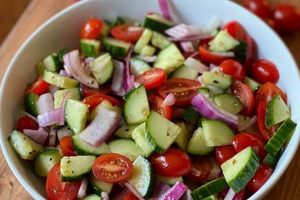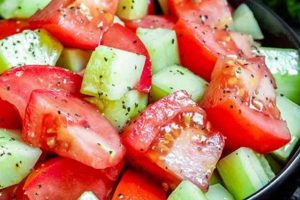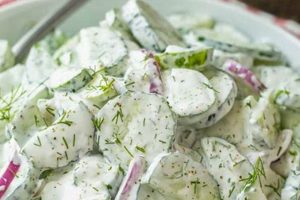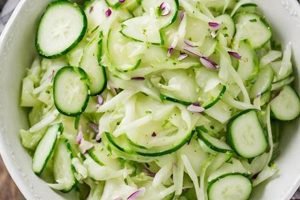A dish combining canned or fresh tuna, cucumber, and other ingredients creates a light and refreshing meal or side. Typical additions include onions (red or green), herbs (dill, parsley, mint), and a dressing (vinaigrette, mayonnaise-based, or yogurt-based). Variations can incorporate other vegetables, such as bell peppers or tomatoes, and seasonings, offering a customizable culinary experience.
This type of salad offers nutritional benefits from the omega-3 fatty acids in tuna, the hydration and vitamins from cucumber, and the added nutrients from other vegetables and herbs. Its adaptable nature allows for variations in flavor profiles and calorie counts, making it suitable for various dietary needs and preferences. Historically, combining readily available ingredients like fish and fresh produce suggests a practical and adaptable approach to meal preparation across cultures.
Further exploration can delve into specific ingredient choices, preparation methods, dressing options, and nutritional information, offering readers a comprehensive guide to creating and enjoying this versatile dish.
Tips for a Delicious Tuna Cucumber Salad
Optimizing ingredient selection and preparation methods elevates this simple salad to a flavorful and satisfying dish.
Tip 1: Quality Tuna Selection: Opting for high-quality canned tuna packed in water or oil, or using fresh, sushi-grade tuna significantly impacts the final flavor. Draining canned tuna thoroughly removes excess liquid, preventing a watery salad.
Tip 2: Cucumber Preparation: Thinly sliced or diced cucumbers provide optimal texture. Consider peeling and seeding cucumbers, particularly if the skin is thick or the seeds are large, to enhance the salad’s delicacy.
Tip 3: Enhancing Flavor with Herbs: Fresh herbs like dill, mint, or parsley contribute brightness and complexity. Chives or finely chopped red onion offer a sharper counterpoint.
Tip 4: Dressing Choices: A simple vinaigrette with lemon juice or vinegar complements the fresh flavors. A creamy dressing based on Greek yogurt or light mayonnaise adds richness.
Tip 5: Balancing Texture: Incorporating ingredients like chopped bell peppers, celery, or avocado introduces textural variety. Toasted nuts or seeds add crunch.
Tip 6: Seasoning Appropriately: Salt and freshly ground black pepper are essential. A pinch of red pepper flakes adds a touch of heat. Experimenting with spices like paprika or cumin can create unique flavor profiles.
Tip 7: Chilling for Optimal Flavor: Allowing the salad to chill in the refrigerator for at least 30 minutes before serving allows the flavors to meld and enhances the refreshing quality of the dish.
By following these guidelines, one can create a tuna cucumber salad that is both flavorful and nutritious, offering a versatile dish suitable for various occasions.
These tips provide a foundation for culinary exploration and customization, encouraging experimentation with different ingredients and flavor combinations.
1. Fresh, High-Quality Ingredients
The success of a tuna cucumber salad rests significantly on the freshness and quality of its core components. Fresh tuna, whether canned or freshly caught, contributes significantly to the overall flavor profile. High-quality canned tuna, packed in water or oil, offers a clean taste, while sushi-grade tuna elevates the dish with its delicate flavor and firm texture. Using fresh tuna minimizes the risk of a “fishy” taste, which can detract from the salad’s refreshing nature. Cucumbers, the other primary ingredient, should be firm and crisp. Fresh cucumbers offer a refreshing crunch and a mild, slightly sweet flavor that complements the tuna. Wilted or overly ripe cucumbers introduce an undesirable softness and a less vibrant taste.
The impact of ingredient quality extends beyond tuna and cucumbers. Fresh herbs, such as dill, mint, or parsley, lose their vibrancy and aromatic qualities when dried or old. Similarly, using fresh, crisp vegetables for additional components like bell peppers or red onions enhances both flavor and texture. A dressing prepared with fresh lemon juice or high-quality vinegar contributes a brighter, more balanced acidity compared to pre-made dressings that may contain additives or preservatives. Even the quality of salt and pepper can influence the final taste. Freshly ground pepper offers a more robust aroma and flavor compared to pre-ground pepper.
Prioritizing fresh, high-quality ingredients elevates the tuna cucumber salad from a simple dish to a culinary experience. The enhanced flavors, textures, and aromas contribute to greater enjoyment and nutritional value. While substitutions or compromises may be necessary at times, understanding the integral role of ingredient quality provides a framework for making informed decisions that optimize the final product. This principle applies not only to tuna cucumber salad but to a wide range of culinary endeavors, highlighting the importance of sourcing and selecting the best possible ingredients.
2. Balanced Flavor Profiles
A successful tuna cucumber salad hinges on a harmonious interplay of flavors. Balancing these flavors elevates the dish beyond a simple combination of ingredients, creating a complex and satisfying culinary experience. Careful consideration of each component’s taste profile, from the primary ingredients to the supporting herbs and dressing, ensures a well-rounded and enjoyable salad.
- Acidity
Acidity plays a crucial role in balancing the richness of the tuna and the mildness of the cucumber. A vinaigrette, typically composed of vinegar or lemon juice, provides the necessary tartness. The level of acidity should be sufficient to brighten the flavors without overpowering the other ingredients. Lemon juice offers a lighter, citrusy acidity, while vinegars like white wine vinegar or apple cider vinegar contribute different nuances. The choice depends on the desired flavor profile and the other components of the salad.
- Saltiness
Salt enhances the flavors of all ingredients and balances the acidity of the dressing. It is essential to season the salad appropriately, considering the saltiness of the tuna itself. Canned tuna packed in oil tends to be saltier than tuna packed in water. Over-salting can mask the delicate flavors of the cucumber and herbs, while under-salting results in a bland dish. Sea salt or kosher salt are preferred for their clean flavor.
- Herbaceousness
Fresh herbs contribute brightness and complexity to the salad. Dill, parsley, mint, and chives are popular choices, each offering a distinct flavor profile. Dill adds a slightly tangy, anise-like flavor, while parsley contributes a fresh, grassy note. Mint provides a cooling element, and chives offer a mild onion flavor. The choice of herbs should complement the other ingredients and the overall flavor profile. Using a combination of herbs can create a more nuanced and interesting taste.
- Texture and Aromatics
Beyond the primary tastes, textural and aromatic elements contribute to a balanced flavor profile. The crunch of the cucumber contrasts with the softness of the tuna, while the addition of ingredients like red onion or bell peppers introduces further textural variety. Aromatics from fresh herbs and spices, such as black pepper or red pepper flakes, enhance the overall sensory experience. These elements add depth and complexity, creating a more engaging and satisfying dish.
Achieving a balanced flavor profile in a tuna cucumber salad requires careful consideration of these interconnected elements. The interplay of acidity, saltiness, herbaceousness, texture, and aromatics ultimately determines the overall taste experience. By understanding these components and their interactions, one can create a salad that is not only refreshing and nutritious but also complex and flavorful.
3. Proper Ingredient Preparation
Proper ingredient preparation is crucial for a successful tuna cucumber salad. It directly impacts the final dish’s texture, flavor, and overall appeal. Careful attention to each component’s preparation ensures a harmonious blend of ingredients and maximizes the salad’s freshness and palatability. Overlooking these steps can result in a watery, bland, or unappetizing salad.
- Tuna Preparation
Tuna, a primary ingredient, requires specific preparation depending on its form. Canned tuna should be thoroughly drained to remove excess liquid, which can make the salad watery. Flaking the tuna into bite-sized pieces ensures even distribution throughout the salad and prevents large clumps. If using fresh tuna, it should be appropriately cut into bite-sized cubes or flakes, depending on the desired presentation and texture. Proper handling of fresh tuna also includes ensuring its freshness and quality to minimize any “fishy” taste.
- Cucumber Preparation
Cucumber preparation significantly impacts the salad’s texture and flavor. Thinly slicing or dicing the cucumber ensures a pleasant crunch and allows the flavors to meld with the other ingredients. Peeling the cucumber removes the sometimes bitter or tough outer skin, resulting in a more delicate texture. Seeding the cucumber eliminates excess moisture and prevents the salad from becoming watery. The choice of slicing, dicing, peeling, and seeding depends on personal preference and the desired salad consistency.
- Herb Preparation
Fresh herbs, such as dill, mint, or parsley, elevate the salad with their bright flavors and aromas. Proper preparation involves gently washing and drying the herbs to remove any dirt or debris. Finely chopping the herbs ensures even distribution of flavor and prevents large, overpowering pieces. Adding the herbs just before serving preserves their delicate flavors and aromas, which can be diminished with prolonged exposure to air or dressing.
- Other Vegetable Preparation
Additional vegetables, such as red onion or bell peppers, introduce textural and flavor complexity. Similar to cucumbers, these vegetables should be appropriately cut, whether thinly sliced, diced, or chopped, to ensure a consistent texture and facilitate even mixing. Soaking sliced red onions in cold water for a short period can mellow their pungent flavor, making them more palatable for some.
Each of these preparatory steps contributes to the overall quality and enjoyment of the tuna cucumber salad. Attention to detail in preparing each component ensures a balanced texture, optimized flavor release, and a visually appealing presentation. These seemingly small steps collectively elevate the dish from a simple mixture of ingredients to a well-executed and satisfying culinary creation.
4. Appropriate Dressing Selection
Dressing selection significantly influences the overall flavor profile and enjoyment of a tuna cucumber salad. The dressing acts as a unifying element, binding the ingredients together and contributing acidity, richness, and complexity. An appropriate dressing complements the inherent flavors of the tuna and cucumber without overpowering them, creating a harmonious balance. An ill-suited dressing can mask the delicate flavors or introduce conflicting tastes, detracting from the salad’s refreshing nature.
Several factors inform appropriate dressing selection. The type of tuna used, whether canned in oil or water or fresh, influences the choice. Tuna packed in oil already possesses a richness that a heavy, creamy dressing might exacerbate. Conversely, tuna packed in water benefits from a dressing that adds flavor and richness. The other ingredients also play a role. A salad with robust additions, such as red onion or bell peppers, can handle a more assertive dressing, while a simpler salad with just tuna, cucumber, and herbs requires a more delicate touch. Personal preferences also factor into the decision-making process, as individual tastes vary regarding acidity, sweetness, and richness.
Examples of appropriate dressings include a classic vinaigrette made with lemon juice or vinegar, olive oil, salt, and pepper. This light and tangy dressing enhances the fresh flavors of the tuna and cucumber without overpowering them. A creamy dressing based on Greek yogurt or light mayonnaise adds richness and body, complementing tuna packed in water. Herb-infused dressings, incorporating fresh dill, mint, or parsley, introduce another layer of flavor complexity. Asian-inspired dressings, utilizing soy sauce, sesame oil, and ginger, offer a savory and umami-rich alternative. Ultimately, the most appropriate dressing depends on the specific ingredients and desired flavor profile, highlighting the importance of considering the interplay of flavors within the salad.
Understanding the impact of dressing selection allows for informed choices that elevate the tuna cucumber salad. A well-chosen dressing transforms individual components into a cohesive and flavorful dish, enhancing the overall dining experience. The interplay of flavors, textures, and aromas created by the appropriate dressing contributes significantly to culinary satisfaction and demonstrates an understanding of balanced flavor composition. Careful consideration of this aspect distinguishes a thoughtfully prepared salad from a mere combination of ingredients.
5. Optimal Chilling Time
Optimal chilling time plays a crucial role in the final quality of a tuna cucumber salad. Chilling allows the flavors of the various ingredients, including the tuna, cucumber, herbs, and dressing, to meld and harmonize. This process enhances the overall taste experience, creating a more cohesive and flavorful salad. Insufficient chilling can result in a disjointed flavor profile, where individual ingredients stand out rather than blending harmoniously. Excessive chilling, on the other hand, can negatively impact the texture of certain ingredients, particularly fresh vegetables like cucumbers, making them overly soft or mushy.
- Flavor Development
Chilling allows the flavors of the individual ingredients to meld and deepen. The acidic notes of the dressing penetrate the tuna and vegetables, while the aromatic compounds in the herbs become more pronounced. This fusion of flavors creates a more complex and nuanced taste profile compared to a freshly made, unchilled salad. The chilling process allows the individual components to harmonize, resulting in a more balanced and integrated flavor experience.
- Texture Enhancement
Optimal chilling enhances the textural contrasts within the salad. The coolness of the chilled ingredients amplifies the crispness of the cucumbers and other vegetables, while the tuna maintains its delicate texture. The chilling process firms the vegetables slightly, enhancing their textural appeal. This interplay of textures contributes to a more satisfying sensory experience, balancing the soft elements with the crisp and crunchy.
- Temperature and Palatability
Serving the salad chilled enhances its refreshing qualities, making it particularly appealing in warmer weather. The cool temperature provides a welcome contrast to the ambient temperature, increasing the salad’s palatability. A chilled salad is more invigorating and enjoyable, especially during hot summer months, offering a refreshing culinary escape.
- Food Safety Considerations
Chilling also plays a critical role in food safety, particularly when using ingredients like mayonnaise-based dressings or fresh tuna. Maintaining the salad at a safe temperature inhibits the growth of harmful bacteria, reducing the risk of foodborne illness. Proper chilling practices are essential for ensuring the safety and quality of the salad, protecting consumers from potential health risks.
Therefore, optimal chilling time is a crucial element in a tuna cucumber salad recipe. It contributes significantly to the development of balanced flavors, desirable textural contrasts, enhanced palatability, and improved food safety. Understanding the impact of chilling time allows for informed decisions that optimize the final product, transforming a simple mixture of ingredients into a well-executed and enjoyable culinary experience. Proper chilling is not merely a matter of convenience but a crucial step that elevates the quality and safety of the salad.
Frequently Asked Questions
This section addresses common inquiries regarding the preparation and enjoyment of tuna cucumber salad.
Question 1: What type of tuna is best suited for this salad?
Canned tuna packed in water or oil offers convenience. For a richer flavor, opt for high-quality canned tuna packed in olive oil or use fresh, sushi-grade tuna. Draining canned tuna thoroughly is crucial for preventing a watery salad.
Question 2: How can one prevent the salad from becoming watery?
Thoroughly draining canned tuna and removing excess moisture from cucumbers, such as by salting and draining or peeling and seeding, are essential. Avoiding overly watery dressings also contributes to maintaining a desirable texture.
Question 3: What are suitable dressing alternatives to mayonnaise-based options?
Vinaigrettes composed of olive oil, lemon juice or vinegar, and seasonings offer a lighter alternative. Greek yogurt-based dressings provide creaminess with a tangier flavor profile. Asian-inspired dressings using soy sauce, sesame oil, and rice vinegar provide a savory option.
Question 4: Can this salad be prepared in advance?
While the salad can be assembled a few hours in advance, adding the dressing immediately before serving prevents the vegetables from becoming soggy. Storing the salad and dressing separately allows for optimal texture and flavor when combined just prior to consumption.
Question 5: How can nutritional value be maximized?
Incorporating a variety of fresh vegetables, such as bell peppers, tomatoes, or spinach, enhances the vitamin and mineral content. Using lean protein sources, such as tuna packed in water, and healthy fats, like those found in olive oil and avocado, further optimizes nutritional value.
Question 6: How long can the salad be stored safely?
Properly stored in an airtight container in the refrigerator, the salad typically remains safe to consume for up to three days. However, the quality and texture may decline over time. Monitoring for any signs of spoilage, such as off-odors or discoloration, is recommended.
Understanding these aspects of preparation and storage ensures optimal enjoyment and food safety.
This comprehensive guide equips readers with the knowledge to create a delicious and satisfying tuna cucumber salad.
Tuna Cucumber Salad Recipe
Exploration of tuna cucumber salad recipes reveals a dish offering adaptable culinary potential. Emphasis on fresh, high-quality ingredients, balanced flavor profiles, proper ingredient preparation, appropriate dressing selection, and optimal chilling time contributes significantly to the final product. Considerations extend beyond mere ingredient combination; a nuanced understanding of these elements distinguishes a truly exceptional salad. This analysis provides a framework for informed decision-making in crafting flavorful and nutritionally balanced variations.
Culinary exploration benefits from an understanding of fundamental principles. Tuna cucumber salad, while seemingly simple, exemplifies the transformative power of thoughtful ingredient selection and preparation. Application of these principles extends beyond this specific dish, offering a foundation for broader culinary creativity and a deeper appreciation for the interplay of flavors and textures. Continued experimentation with ingredients and techniques unlocks further culinary potential and personalized variations.






